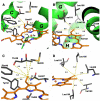Crystallographic trapping of heme loss intermediates during the nitrite-induced degradation of human hemoglobin
- PMID: 21863786
- PMCID: PMC3209482
- DOI: 10.1021/bi2009322
Crystallographic trapping of heme loss intermediates during the nitrite-induced degradation of human hemoglobin
Abstract
Heme is an important cofactor in a large number of essential proteins and is often involved in small molecule binding and activation. Loss of heme from proteins thus negatively affects the function of these proteins but is also an important component of iron recycling. The characterization of intermediates that form during the loss of heme from proteins has been problematic, in a large part, because of the instability of such intermediates. We have characterized, by X-ray crystallography, three compounds that form during the nitrite-induced degradation of human α(2)β(2) hemoglobin (Hb). The first is an unprecedented complex that exhibits a large β heme displacement of 4.8 Å toward the protein exterior; the heme displacement is stabilized by the binding of the distal His residue to the heme Fe, which in turn allows for the unusual binding of an exogenous ligand on the proximal face of the heme. We have also structurally characterized complexes that display regiospecific nitration of the heme at the 2-vinyl position; we show that heme nitration is not a prerequisite for heme loss. Our results provide structural insight into a possible pathway for nitrite-induced loss of heme from human Hb.
Figures





Similar articles
-
Nitrite attenuated hypochlorous acid-mediated heme degradation in hemoglobin.Chem Biol Interact. 2015 Aug 5;238:25-32. doi: 10.1016/j.cbi.2015.05.021. Epub 2015 Jun 5. Chem Biol Interact. 2015. PMID: 26051522
-
The distal pocket histidine residue in horse heart myoglobin directs the O-binding mode of nitrite to the heme iron.J Am Chem Soc. 2009 Dec 23;131(50):18119-28. doi: 10.1021/ja904726q. J Am Chem Soc. 2009. PMID: 19924902 Free PMC article.
-
Covalent heme attachment in Synechocystis hemoglobin is required to prevent ferrous heme dissociation.Protein Sci. 2007 Feb;16(2):250-60. doi: 10.1110/ps.062572607. Protein Sci. 2007. PMID: 17242429 Free PMC article.
-
Reactivity of the human hemoglobin "dark side".IUBMB Life. 2013 Feb;65(2):121-6. doi: 10.1002/iub.1121. Epub 2013 Jan 3. IUBMB Life. 2013. PMID: 23288658 Review.
-
Nitrite binding to myoglobin and hemoglobin: Reactivity and structural aspects.J Inorg Biochem. 2025 Apr;265:112829. doi: 10.1016/j.jinorgbio.2025.112829. Epub 2025 Jan 11. J Inorg Biochem. 2025. PMID: 39854981 Review.
Cited by
-
Integrative and comparative reproductive biology: From alligators to xenobiotics.Gen Comp Endocrinol. 2016 Nov 1;238:23-31. doi: 10.1016/j.ygcen.2016.03.026. Epub 2016 Mar 21. Gen Comp Endocrinol. 2016. PMID: 27013381 Free PMC article. Review.
-
Nitric Oxide Binding Geometry in Heme-Proteins: Relevance for Signal Transduction.Antioxidants (Basel). 2024 May 29;13(6):666. doi: 10.3390/antiox13060666. Antioxidants (Basel). 2024. PMID: 38929104 Free PMC article. Review.
-
Nitrosyl Myoglobins and Their Nitrite Precursors: Crystal Structural and Quantum Mechanics and Molecular Mechanics Theoretical Investigations of Preferred Fe -NO Ligand Orientations in Myoglobin Distal Pockets.Biochemistry. 2018 Aug 14;57(32):4788-4802. doi: 10.1021/acs.biochem.8b00542. Epub 2018 Jul 27. Biochemistry. 2018. PMID: 29999305 Free PMC article.
-
Crystallographic characterization of the nitric oxide derivative of R-state human hemoglobin.Nitric Oxide. 2014 May 30;39:46-50. doi: 10.1016/j.niox.2014.04.001. Epub 2014 Apr 22. Nitric Oxide. 2014. PMID: 24769418 Free PMC article.
-
Leghemoglobin green derivatives with nitrated hemes evidence production of highly reactive nitrogen species during aging of legume nodules.Proc Natl Acad Sci U S A. 2012 Feb 14;109(7):2660-5. doi: 10.1073/pnas.1116559109. Epub 2012 Jan 30. Proc Natl Acad Sci U S A. 2012. PMID: 22308405 Free PMC article.
References
-
- Boon EM, Marletta MA. Ligand Specificity of H-NOX Domains: From sGC to Bacterial NO Sensors. J. Inorg. Biochem. 2005;99:892–902. - PubMed
-
- Guengerich FP, editor. Human Cytochrome P450 Enzymes. 3rd Ed Kluwer Academic/Plenum; New York: 2005.
-
- Hargrove MS, Singleton EW, Quillin ML, Ortiz LA, Phillips GN, Olson JS, Mathews AJ. His(64)(E7)→Tyr Apomyoglobin as a Reagent for Measuring Rates of Hemin Dissociation. J. Biol. Chem. 1994;269:4207–4214. - PubMed
-
- Hargrove MS, Wilkinson AJ, Olson JS. Structural Factors Governing Hemin Dissociation from Metmyoglobin. Biochemistry. 1996;35:11300–11309. - PubMed
Publication types
MeSH terms
Substances
Associated data
- Actions
- Actions
- Actions
Grants and funding
LinkOut - more resources
Full Text Sources

